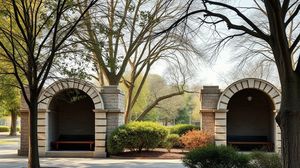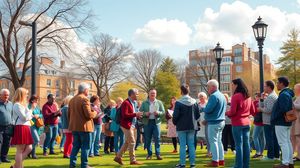
The House Mill, located in Bromley-by-Bow, is one of London's hidden gems, offering a fascinating peek into the city's industrial past. It is an iconic Grade I listed building, celebrated as the world's largest surviving tidal mill. Positioned on the River Lea, it forms part of the historically significant Three Mills Island.
Dating back to 1776, The House Mill stands as a remarkable testament to the period when milling played a crucial role in London's economy. The structure you see today has been through numerous modifications over the years, but it still retains many of its original elements, showcasing the craftsmanship of the 18th century.
One of the mill's unique features is its four giant water wheels. These once harnessed the tidal power of the River Lea to grind grain for gin distilleries in the area. This connection with the distillation industry is particularly intriguing, as it highlights the intertwined nature of food production and alcohol manufacturing in historic London.
The House Mill is not just about its mechanical ingenuity; it also has a remarkable architectural layout. The building's distinct and beautiful Georgian construction is a delight, with its red brick facade and white windows, offering an impressive sight against the backdrop of the modern cityscape.
A peculiar aspect of The House Mill is its role as a rare example of a surviving multiple-mill complex. It forms part of the Three Mills, together with the Clock Mill and a third mill that no longer exists. Their collective history spans centuries, adding layers of rich narratives to the site.
Besides its historical machinery, The House Mill also serves as a cultural venue where various events and activities are organized. The building acts as a hub for heritage tours and creative workshops, providing a lively and informative experience for visitors keen on understanding London's past.
Interestingly, due to its position on the tidal part of the River Lea, The House Mill is subject to unique environmental influences. Twice a day, the tides influence the operation of the mill, a feature that has contributed to its historical significance and makes visiting the site a dynamic experience.
The future of The House Mill is promising, with ongoing efforts to restore and preserve its structure and machinery. These initiatives ensure that the mill remains an educational resource and a beautiful landmark for generations to appreciate.

Making the Most of Your Visit:
First off, make sure you check if the House Mill is open for guided tours on the day you want to visit. They're usually held on Sundays from May to October, but it's always good to be certain, so you don't miss out on insights from the passionate volunteer guides.
While you're there, pay close attention to the original Georgian architecture. Look for the subtle craftsmanship details like the ornate brickwork and the unique wooden beams – they really give you a sense of the building's age and historical importance.
Don't forget to explore the surrounding area of Three Mills Island. It's a great spot for some peaceful walking along the River Lea, and if you're lucky, you'll catch a glimpse of local wildlife. This adds a different dimension to the industrial history you soak up inside The House Mill.
Make sure to spend some time in the small but delightful café after your tour. It's hidden right next to the mill and serves some charming homemade cakes and hot drinks—perfect for relaxing and reflecting on the fascinating history you've just learned about.
If you're interested in the tidal mechanics of the mill, try to plan your visit around the high tide. It's when the operation of the mill can be best appreciated, giving you a real sense of how it once functioned as part of London's industrial past.

Visiting Times & Costs:
The House Mill is generally open to the public for guided tours on Sundays from May to October. It is advisable to check specific dates and times as availability can vary.
Admission charges may apply, often including a small fee for the guided tour, as the site relies on contributions to aid its restoration and preservation efforts. Prices are subject to change, so it is recommended to confirm the cost prior to your visit.
Accessibility can be a concern as the site is a historic building with limitations, including uneven surfaces and stairs. Efforts are made to accommodate visitors, but those with mobility issues are advised to contact the venue prior to their visit for specific information.

Address & Map:

Nearby:























